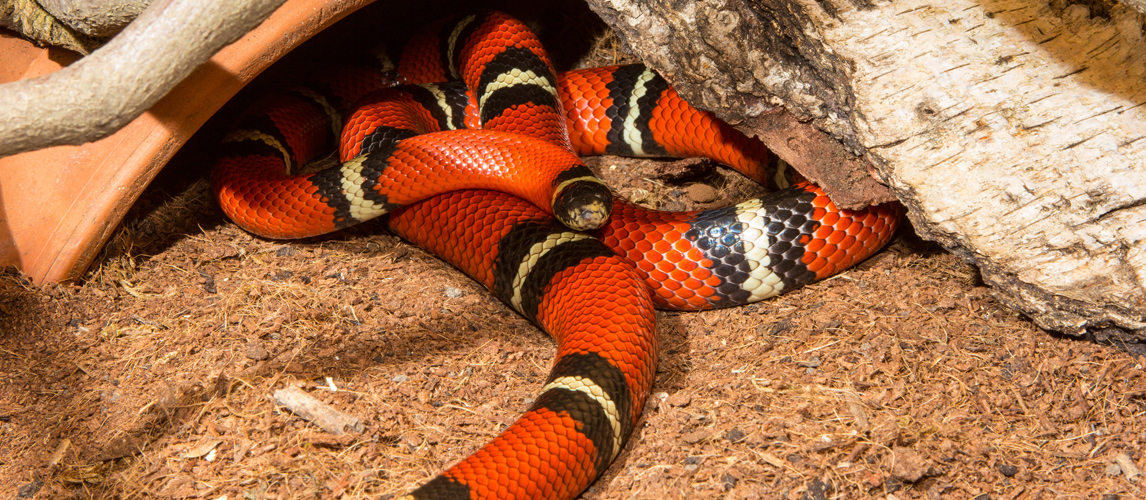A few years ago I had a friend who had kept snakes his entire life. He kept them in their own temperature controlled room that was carefully ‘snake-proofed’ and had a door that made you feel more like you were going into a safe than a room. Obviously, most people can’t afford to have a special snake room, especially if you aren’t sure if snakes are the pet for you. But if you are interested in becoming a snake parent, there are easier, simple snakes you can start with. Here are five snake breeds to get you started.
1. Corn Snake
Corn snakes are a local North American snake that are calm and come in a variety of colors. They are very common and popular, so are easily available and easy to breed. This makes them relatively inexpensive at $25 to $40. The Pantherophis guttata, as it is also known, do not grow to difficult sizes, and can often be kept in a 20-gallon enclosure for their whole lives. Their average length is between 4 to 5 feet, although it is worth noting that a 5 foot snake may need a bigger enclosure. All you need for a corn snake’s environment is:
- A 20 gallon enclosure with a screened top
- A tank heat pad under the enclosure
- A ceramic water bowl
- A couple of hiding spots, such as a paper towel roll
- Bedding, like aspen substrate
You don’t need to provide them with special lighting, and feeding is fairly standard using frozen or thawed rat pups or mice. It can be helpful to take them out of their enclosure to feed them. Prepare to take responsibility for your corn snake for many years. While they usually live to around 8 years in the wild, they have been known to survive into the 20s in captivity.
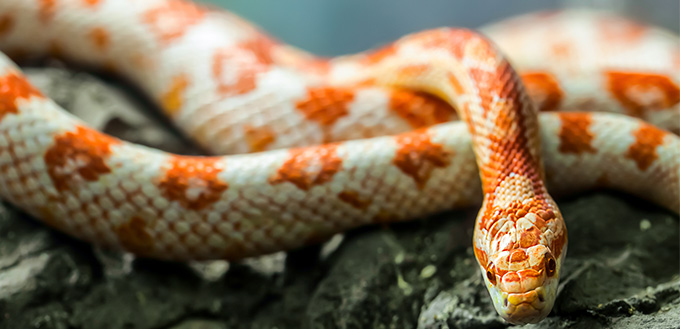
2. California Kingsnake
If you are looking for a more dangerous and exciting snake that is still manageable for beginners, the California Kingsnake is a great option. As the name suggests, they are native to Southern California, where they hunt for a huge variety of meals from other snakes and lizards to bird eggs and birds. It is worth highlighting that these snakes can be nippy and may bite you if you do not spend enough time with them. Handle them often and this should not be a problem.
You can buy this snake, also known as a Lampropeltis getula californiae, for approximately $50. They generally grow to 3 to 4 feet in length, which means that you need to provide your California kingsnake with:
- A 20-gallon enclosure with a screened top
- A couple of hiding spots
- Bedding
- An under tank heater to help them regulate their temperature and digestion
- A water bowl that they can drink from, soak in, and that they won’t knock over
You won’t need to invest in special lighting. Feeding needs to develop as your snake grows older and bigger. A hatchling needs pinky mice that are smaller than their girth, and you need to get larger and larger mice until they are consuming adult mice.
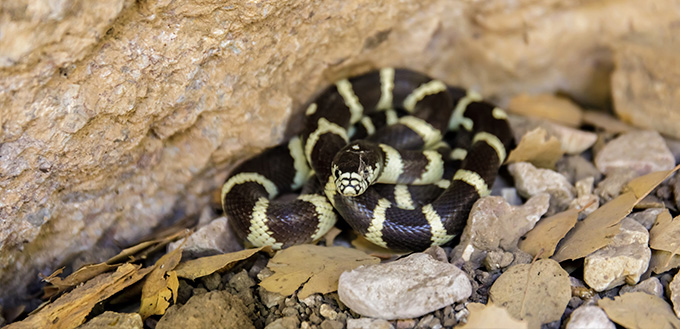
3. Rosy Boa
As the name suggests, the rosy boa is a very pretty snake with an almost pastel color pallet. Although they aren’t as popular as the corn snake and the California kingsnake, they are a very affordable option at $30 to $40. However, if you are interested in the lichanura trivirgata, you might not be able to find them at all pet stores due to their relative lack of popularity. You may need to try your luck at reptile shows or the internet. You must be prepared for a commitment when you get a rosy boa as they have been known to live up to 25 years.
At 2 to 3 feet, the rosy boa is a very manageable size. Therefore, if you have a rosy boa, you need to have:
- A 20-gallon enclosure for an adult, but you can start with a shoebox for a hatchling
- Newspaper, paper towels or aspen substrate for bedding
- A heat source, such as an under tank heating pad.
- A water bowl
- Fun hiding spots
As with the other easy-to-manage snakes, there is no need to provide special lighting and you should feed them mice that is appropriate for their size. This feeding should rise and fall with the seasons, as a snake’s natural hibernation cycle makes them need less food in winter and more in spring. On average, your rosy boa needs a mouse up to four times a month, lowering to twice a month in the coldest months.
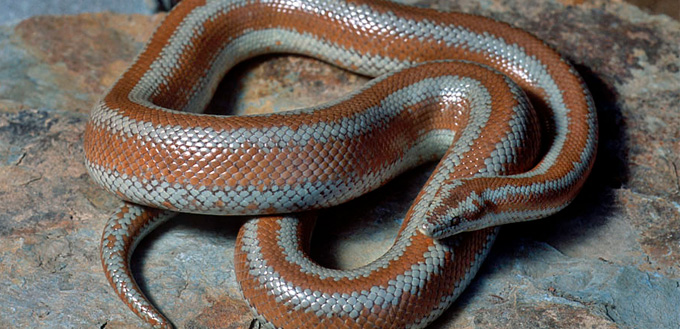
4. Gopher Snake
The pituophis spp, which is more commonly known as the gopher snake, is another relatively uncommon snake. However, it can be easier to find a gopher snake for sale than a rosy boa and their prices are similarly reasonable at $50 at pet shops. It is possible to find even more affordable gopher snakes at reptile shows. If you own a gopher snake, prepare to care for them for as much as 15 years.
Gopher snakes can grow up to six feet so, as one of the larger snakes on the list, the environment you need to offer your gopher snake includes:
- A 20-gallon enclosure when a hatchling, moving to a 30-gallon enclosure as an adult
- Two to three inches of bedding to allow them to burrow
- A heat source on one side of the enclosure to allow them to thermoregulate
- Water bowl that is large enough for them to soak in
- Fun hiding spots
As always, special lighting in unnecessary and you can offer them frozen or thawed mice to eat that are an appropriate size for their stage of development.
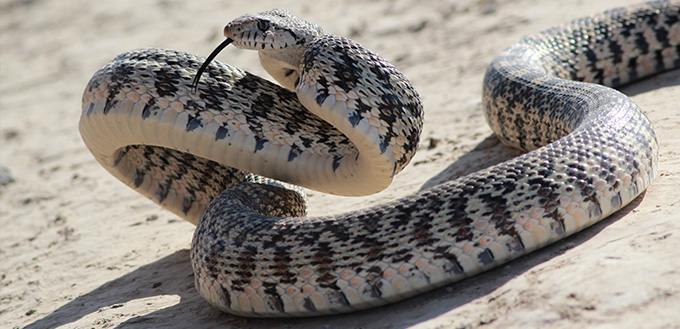
Related Post: Why Do Snakes Yawn?
5. Ball Python
The ball python is a little bit more of a challenge than the other beginner snakes on this list. If you have had reptiles or exotic pets in the past or are an experienced pet owner, you may want to start with a snake that requires a little more attention, without being too overwhelming. Their specific requirements centre around their difficult eating patterns.
Ball pythons have been known to stop eating, leading to many worried owners want to know ‘why my ball python won’t eat’. Most of the time, this is nothing to worry about. Ball pythons might stop eating for a few months, but if they have no symptoms of illness, their weight remains the same and there are no other changes in their behavior, then they are completely fine.
Other than these feeding challenges, ball pythons are similar to the other snakes on this list. They may be the cheapest at $30, and possibly the smallest as male pythons do not usually exceed 3 feet. Females can reach 5 feet. Their price can vary wildly, however, as some colors and patterns are rare, but beware of overpriced ball pythons. You can usually haggle at reptile shows, so prices may be inflated to reflect this.
If you go for a ball python, you must be aware that they can live to 30 or even 40 years. They also have a particular personality trait of shyness, so caring for a ball python over these decades means you should provide them with:
- A hide box, and other hiding spots.
- A 30-gallon enclosure without a screen top. The size is needed to ensure the hide box will fit while providing your snake with enough space to move, and the screen-top can allow humidity to escape, which is needed for a ball python to shed properly.
- A sturdy water bowl that they can soak in
- A heat pad or hot spot on one end of the enclosure
- Newspaper or paper towel bedding
As always, supplemental lighting is unnecessary, and you feed ball pythons prey items, such as mice, that are appropriate for their size.

Check out our article on: Rough Green Snake: Complete Care Guide and Introduction
Getting Your First Snake
Finding your first snake is not just about getting the right breed, although that is very important. There are also other considerations that you must make before you make the commitment to your newest addition to the family.
- Understand the risks. Snakes might not only bite, but can carry salmonella. This is easy to manage, however, by washing your hands thoroughly every time you handle your snake.
- Understand snakes. Snakes are solitary animals who like the quiet and need consistency and routine. This means they shouldn’t share habitats and you shouldn’t badger them or handle them excessively. They do, however, like playing and some socializing, so should be handled for about five minutes a day.
- Provide the right environment. Snakes do not manage their temperature in the same way that humans do, so they will need a warm are and a colder area of their environment using a heat lamp or pad, complete with two thermometers and a humidity gauge. They also need hiding spaces, bedding, and water for both drinking and bathing. Artificial plants can also be a fun addition.
- Feed them correctly. You must be prepared to feed them raw meat like mice and rats, so if you are squeamish, this pet is not for you.
- Keep them clean. Spot cleaning for droppings is very necessary to keep their day-to-day lives hygienic, but you must also do a regular bedding change and deep clean of their enclosure.
Related Post: Best Snake Bedding
Sources:
- Mark Mancini, Corn Snakes Are Perfect Pets For Reptile Enthusiasts, HowStuffWorks
- Getting a Pet Snake, WebMD
- Laurie Hess, DVM, Owning a Pet Snake, VCA Hospitals







